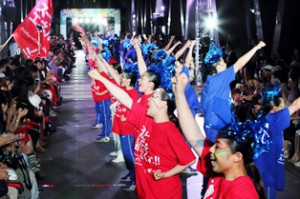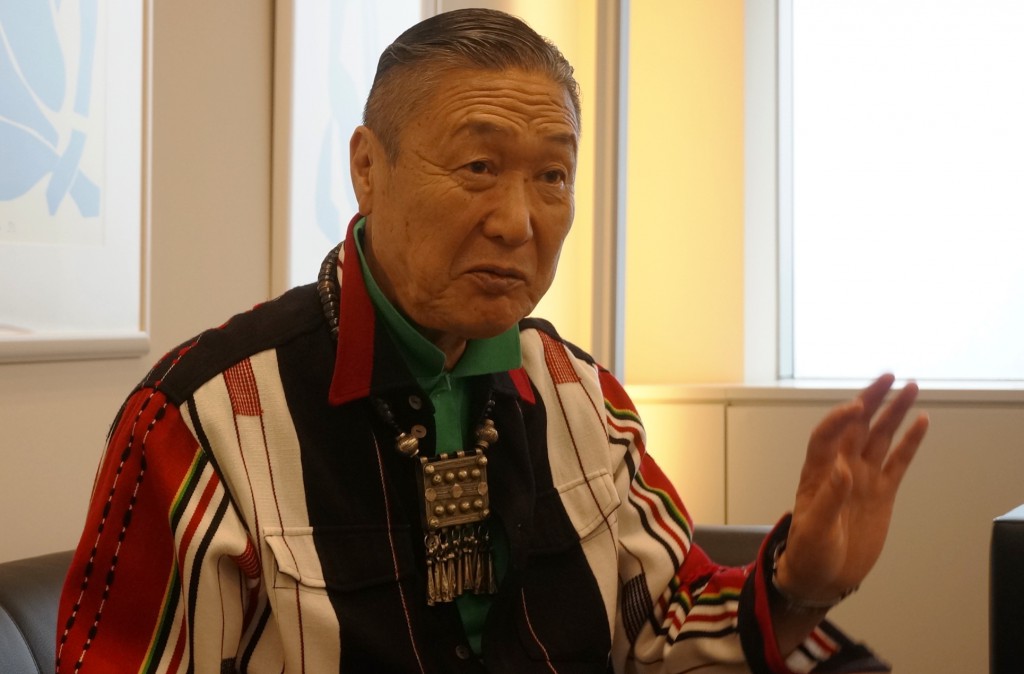Mr. Kansai Yamamoto / Designer, Event Producer (Vol.2)
This second installment of articles from the interview with Kansai Yamamoto, a world-renowned designer and event producer, centers around his events held in Japan as well as discussions on how best to convey his messages abroad.
 Foreign Press Center (FPCJ): You have orchestrated a large number of events not only in foreign countries, but also in Japan, including “Taiyo no Fune (The Sun Vessel)” (Tokyo Dome, 2007) and “Tento—SKY LIGHT” (Soma City, Fukushima Prefecture, 2011). Are there any differences between the purpose of holding events in Japan and abroad?
Foreign Press Center (FPCJ): You have orchestrated a large number of events not only in foreign countries, but also in Japan, including “Taiyo no Fune (The Sun Vessel)” (Tokyo Dome, 2007) and “Tento—SKY LIGHT” (Soma City, Fukushima Prefecture, 2011). Are there any differences between the purpose of holding events in Japan and abroad?
Kansai Yamamoto: We call events we organize in Japan, “The Japan Genki (Energize Japan) Project.” What is “genki (energy, vigor)”? We can be energized with a nutritional tonic, we can be energized by a workout at the gym. Then, I wondered, “What can energize people’s minds?” We are holding The Japan Genki Project in the hopes of energizing people even a little bit.
Unfortunately, however, I think the amount of financial sponsorship contributed by companies to such activities has declined since the financial crisis triggered in 2008 by the collapse of Lehman Brothers. Before that, I sent hand-written letters to top-notch companies to persuade them to contribute funds for my projects. This is no longer an effective way, however. So I am employing new ways to raise funds for my projects now.
FPCJ: What sorts of messages do you want to convey in the run-up to the Tokyo Olympics and Paralympics in 2020?
 Kansai Yamamoto: We held “Super Energy!!” at the Museum of Contemporary Art Tokyo in June 2015. We are planning another project for this fiscal year, and we want to drastically change our way of thinking and make it more in line with the times. In “Super Energy!!” we focused on energy humans possess. We are currently considering whether we should pursue the same concept or not.
Kansai Yamamoto: We held “Super Energy!!” at the Museum of Contemporary Art Tokyo in June 2015. We are planning another project for this fiscal year, and we want to drastically change our way of thinking and make it more in line with the times. In “Super Energy!!” we focused on energy humans possess. We are currently considering whether we should pursue the same concept or not.
We send our message each time we hold a show. What intrigues me now are roofs. Recently, I recognized that the beauty of Nijo Castle lies with its roofs. Naritasan Shinshoji Temple in Chiba Prefecture was the second one that attracted my attention for its beautiful roofs. Also, there are the city hall and other old buildings along rivers in Osaka. The copper on their roofing has been oxidized and become green. They are beauties created by roofs.
I am not trying to take up only Japanese things. By strengthening our message year by year, we’d like to underscore the self-awareness Japanese have and where Japanese excel. Actually, I am trying to publish a book based on my diaries I will have written in the run up to the next event. I will take notes of what I feel and then make a book out of them. I think many people would be surprised to find out how tenaciously Kansai is thinking about fine details every day.
FCPJ: It has been said Japanese efforts to convey their messages abroad are insufficient. Recently, however, Japanese Halloween has attracted a lot of attention overseas. Is this a harbinger of change?
Kansai Yamamoto: I went to an event featuring music and lighting at the Yokohama Arena during the Halloween weekend. When I saw young people who gathered there, I questioned myself: “Did Japanese people assert themselves with what they wear like this before?” As I observed what was happening in Shibuya during the weekend on TV, I thought, “Nothing like this happened before.” Japanese were not assertive to such an extent—not with what they wear. What bothered me, however, was that in many cases, pairs or several people were wearing the same costumes. This event of Europe and the United States has gone through a transformation after being adopted in Japan, becoming a major event like Christmas.
Recently, I read “Murakami Haruki Zatsubun-shu (Collection of miscellanea by Haruki Murakami).” In the book, Mr. Murakami noted that Japanese people, in general, do not stick out and that Japan is a nation of conformists. In contrast, Americans and Europeans respect being individualistic. Basically, I think he is right in saying so. While the old notion of trying not to stand out among people remains, there emerged a prevailing notion of people asserting themselves—exemplified by what happened at Halloween.
FPCJ: Young people nowadays are said to be inward-looking and reluctant to go overseas for study. You have a lot of opportunities to associate with Japanese youths via the Japan Genki Project and other occasions. Do you have any message you want to convey to them?
Kansai Yamamoto: One of my grandchildren went to Africa as a volunteer to serve as a medical nursing assistant when she was a high school student. She is very active, isn’t she? Her first language is English, followed in fluency by Japanese and Chinese. As there are various kinds of young people in this nation, it is dangerous to lump them together as one when we describe them.
At the Yokohama Arena event, I saw Exile members perform. Their movements are originally from Michael Jackson and street dance in Los Angeles, But I think Japan may be unrivaled now (in this category of dancing). I also saw laser lighting for the first time in many years. The way they use the lighting is very good and continues to evolve. It is not a good idea to characterize young people as though they are one. People are different from one another.
There is one thing I want to say. People feel as if they visited places by merely getting information about them on the Internet. That is a huge mistake. Temperature, mosquitos and smells are cases in point. You will never know them unless you are there. I learned this when I visited an Amazon jungle. I’d like to say to young people you should be right there to experience things you know from online information.
Having said that, I have to admit I have never been to a baseball game. I have been to a training room for sumo wrestlers but never watched a grand sumo tournament from a seat near the ring. I assume I know things, but when I question myself, I realize I have never been to a rugby match or an ice show. There are many things that I assume I know but turn out to be otherwise. I have never gone out on New Year’s Eve to visit a temple or a shrine. So, I am planning to go to Naritasan (Shinshoji Temple) on this New Year’s Eve. Being more active is my priority now.
To be continued in the third installment of the articles.
—————————————————————————————————————–
Kansai Yamamoto
Born in 1944, Kansai Yamamoto is a world-renowned designer and producer. He has received numerous awards, including the Fashion Editors Club Award, the Jury’s Special Award at the 7th Japan Event Award, the International Award at the 7th Tokyo Creation Award, the Good Design Award and the Blue Ribbon Award. He is a founding board member of the Tokyo Fashion Designer Committee and an Overseas Advisor to the Russia International Human Aid Foundation. He has authored many books, including “Ue wo Muite (Looking Up)” (Shodensha Co., 2012) and “Atsuki Kokoro (Passionate Heart)” (PHP Shinsho, 2008).



